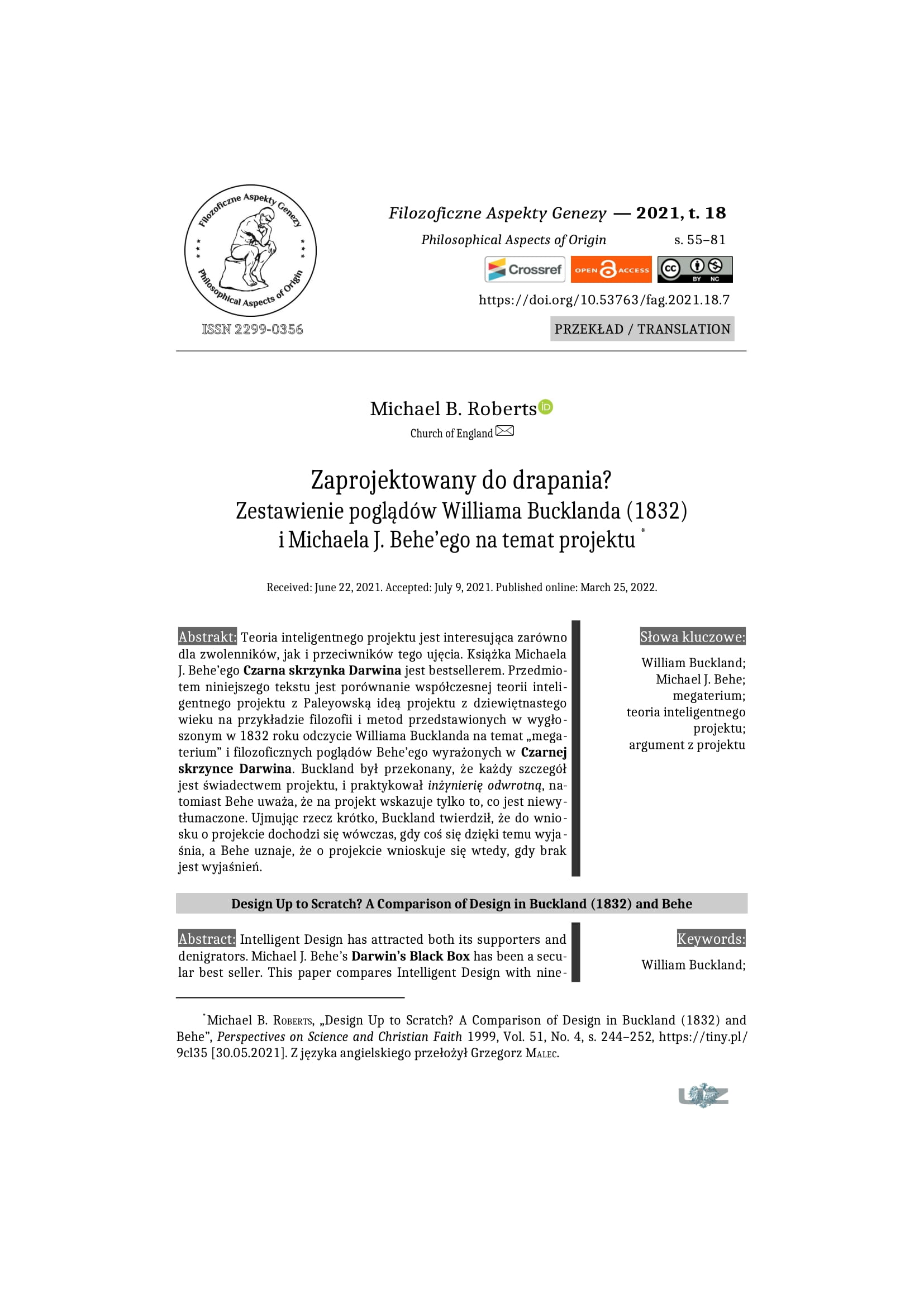Zaprojektowany do drapania? Zestawienie poglądów Williama Bucklanda (1832) i Michaela J. Behe'ego na temat projektu

Opublikowane 25.03.2022 — zaktualizowane 15.04.2022
Wersje
- 15.04.2022 - (3)
- 25.03.2022 - (2)
- 25.03.2022 - (1)
Słowa kluczowe
- William Buckland,
- Michael J. Behe,
- megaterium,
- teoria inteligentnego projektu,
- argument z projektu
Prawa autorskie (c) 2022 Filozoficzne Aspekty Genezy

Utwór dostępny jest na licencji Creative Commons Uznanie autorstwa – Użycie niekomercyjne 4.0 Międzynarodowe.
Jak cytować
Abstrakt
Teoria inteligentnego projektu jest interesująca zarówno dla zwolenników, jak i przeciwników tego ujęcia. Książka Michaela J. Behe’ego Czarna skrzynka Darwina jest świeckim bestselerem. Przedmiotem niniejszego tekstu jest porównanie współczesnej teorii inteligentnego projektu z Paleyowską ideą projektu z dziewiętnastego wieku na przykładzie filozofii i metod przedstawionych w wygłoszonym w 1832 roku odczycie Williama Bucklanda na temat „megaterium” i filozoficznych poglądów Behe’ego wyrażonych w Czarnej skrzynce Darwina. Buckland był przekonany, że każdy szczegół jest świadectwem projektu, i praktykował inżynierię odwrotną, natomiast Behe uważa, że na projekt wskazuje tylko to, co jest niewytłumaczone. Ujmując rzecz krótko, Buckland twierdził, że do wniosku o projekcie dochodzi się wówczas, gdy coś się dzięki temu wyjaśnia, a Behe uznaje, że o projekcie wnioskuje się wtedy, gdy brak jest wyjaśnień.
Downloads
Bibliografia
- Altholz Josef L. (ed.), The Mind and Art of Victorian England, University of Minnesota Press, Minnesota 1976.
- Altholz Josef L., The Warfare of Conscience with Theology, w: Altholz (ed.), The Mind and Art of Victorian England…, s. 58–77.
- Babbage Charles, The Ninth Bridgewater Treatise: A Fragment, John Murray, London 1837.
- Barrett Paul H., Gautrey Peter J., Herbert Sandra, Kohn David, and Smith Sydney (eds.), Charles Darwin’s Notebooks, 1836–1844, Cambridge University Press, New York 1987.
- Behe Michael J., Czarna skrzynka Darwina. Biochemiczne wyzwanie dla ewolucjonizmu, przeł. Dariusz Sagan, Seria Inteligentny Projekt, Fundacja En Arche, Warszawa 2020.
- Bell Charles, The Hand, its Mechanism and Vital Endowments as Evincing Design. Treatise IV, William Pickering, London 1833.
- Black Riley, The School of Hard Knocks: Finding the «Sweet Spot» on Glyptodont Tails, National Geographic 2009, October 15, https://tiny.pl/9nrbn [30.05.2021].
- Blake William, Poezje wybrane, przeł. Zygmunt Kubiak, Ludowa Spółdzielnia Wydawnicza, Warszawa 1991.
- Brooke John H. and Cantor Geoffrey, Reconstructing Nature: The Engagement of Science and Religion, T. and T. Clark, Edinburgh 1998.
- Buckland William, Geology and Mineralogy Considered with Reference to Natural Theology. Treatise VI, Vol. I–II, William Pickering, London 1836.
- Buffon Georges-Louis Leclerc de, Natural History: General and Particular, Vol. IX, T. Cadell and W. Davies, London 1812.
- Campbell George, The Philosophy of Rhetoric, 2 Vols., Edinburgh 1808.
- Cannon Walter F., Scientists and Broad Churchmen: An Early Victorian Intellectual Network, Journal of British Studies 1964, Vol. 4, No. 1, s. 65–88.
- Chalmers Thomas, The Adaptation of External Nature to the Moral and Intellectual Condition of Man. Treatise I, Vol. I–II, William Pickering, London 1833.
- Cuvier Georges, Essays on the Theory of the Earth, W. Blackwood, Edinburgh 1815.
- Cuvier Georges, Recherches sur les ossements fossiles de quadrupedes, Flammarion, Paris 1992.
- Darwin Charles, Darwin’s Abstract of John Macculloch 1837: Proofs and Illustrations of the Attributes of God, w: Barrett, Gautrey, Herbert, Kohn, and Smith (eds.), Charles Darwin’s Notebooks…, s. 632–641.
- Darwin Charles, On the Origin of Species by Means of Natural Selection, or the Preservation of Favoured Races in the Struggle for Life, John Murray, London 1859.
- Darwin Karol, Autobiografia i wybór listów. Dzieła wybrane, t. VIII, przeł. A. Iwanowska, A. Krasicka, J. Połtowicz, S. Skowron, Biblioteka Klasyków Biologii, Państwowe Wydawnictwo Rolnicze i Leśne, Warszawa 1960.
- Darwin Karol, O powstawaniu gatunków drogą doboru naturalnego, czyli o utrzymaniu się doskonalszych ras w walce o byt. Dzieła wybrane, t. II, przeł. Szymon Dickstein i Józef Nusbaum, Biblioteka Klasyków Biologii, Państwowe Wydawnictwo Rolnicze i Leśne, Warszawa 1959.
- Dawkins Richard, Ślepy zegarmistrz, czyli jak ewolucja dowodzi, że świat nie został zaplanowany, przeł. Antoni Hoffman, Biblioteka Myśli Współczesnej, Państwowy Instytut Wydawniczy, Warszawa 1994.
- Dennett Daniel C., Darwin’s Dangerous Idea, Penguin, Harmondsworth 1995.
- Eliot George, Młyn and Flossą, przeł. Anna Przedpełska-Trzeciakowska, Czytelnik, Warszawa 1960.
- Fariña Richard A., Megatherium, el pelado: sobre la apariencia de los grandes perezosos (Mammalia; Xenarthra) cuaternarios, Ameghiniana 2002, Vol. 39, No. 2, s. 241–244.
- Gonzalez Guillermo i Richards Jay W., Wyjątkowa planeta. Dlaczego nasze położenie w kosmosie umożliwia odkrycia naukowe, przeł. Grzegorz Malec i Dariusz Sagan, Seria Inteligentny Projekt, Fundacja En Arche, Warszawa 2021.
- Gould Stephen Jay, Time’s Arrow, Time’s Cycle: Myth and Metaphor in the Discovery of Geological Time, The Jerusalem-Harvard Lectures, Harvard University Press, Harmondsworth 1988.
- Hopkins Gerard Manley, Poematy, przeł. Stanisław Barańczak, Wydawnictwo Znak, Kraków 1996.
- Johnson Phillip E., Darwin przed sądem, przeł. Patrycja Drygas, Seria Inteligentny Projekt, Fundacja En Arche, Warszawa 2020.
- Kidd John, On The Adaptation of External Nature to the Physical Condition of Man. Treatise II, William Pickering, London 1833.
- Kirby William, On the History, Habits and Instincts of Animals. Treatise VII, William Pickering, London 1835.
- List Mary Buckland do Williama Whewella z 12 maja 1833 roku, w: Morrell and Thackray, Gentlemen of Science…, s. 169.
- Macculloch John, Proofs and Illustrations of the Attributes of God from the Facts and Laws of the Physical Universe, being the Foundation of Natural and Revealed Religion, Vol. I–III, J. Duncan, London 1837.
- Medawar Peter, The Art of the Soluble, Methuen & Co., Barnes and Noble, London — New York 1967.
- Moore John A., Science as a Way of Knowing: The Foundations of Modern Biology, Harvard University Press, Cambridge 1993.
- Morrell Jack and Thackray Arnold, Gentlemen of Science: Early Correspondence of the British Association for the Advancement of Science, Camden Fourth Series, No. 30, Royal Historical Society, London 1984.
- Paley William, Natural Theology: or, Evidences of the Existence and Attributes of the Deity; Collected from the Appearances of Nature, American Tract Society, New York 1802.
- Pike David L., «The Greatest Wonder of the World»: Brunel’s Tunnel and the Meanings of Underground London, Victorian Literature and Culture 2005, Vol. 33, No. 2, s. 341–367.
- Prout William, Chemistry, Meteorology, and the Function of Digestion, Considered with Reference to Natural Theology. Treatise VIII, William Pickering, London 1834.
- Roberts Michael B., Darwin’s Black Box Reconsidered, Science and Christian Belief 1998, Vol. 10, No. 2, s. 189–195.
- Roberts Michael B., Just Before the Beagle: Charles Darwin’s Geological Fieldwork in Wales, Summer 1831, Endeavour 2001, Vol. 25, No. 1, s. 33–37.
- Roberts Michael B., Review of Behe, Darwin’s Black Box, Science and Christian Belief 1997, Vol. 9, s. 192.
- Roget Peter Mark, Animal and Vegetable Physiology Considered with Reference to Natural Theology. Treatise V, Vol. I–II, William Pickering, London 1834.
- Rupke Nicolaas A., The Great Chain of History: William Buckland and the English School of Geology, 1814–1849, Oxford University Press, Oxford 1983.
- Sagan Dariusz, Metodologiczno-filozoficzne aspekty teorii inteligentnego projektu, Biblioteka Filozoficznych Aspektów Genezy, t. 6, Instytut Filozofii Uniwersytetu Zielonogórskiego, Zielona Góra 2015.
- Scott Eugenie C., Creationists and the Pope’s Statement, The Quarterly Review of Biology 1997, Vol. 72, No. 4, s. 401–406.
- Van Till Howard J., Special Creationism in Designer Clothing: A Response to The Creation Hypothesis, Perspectives on Science and Christian Faith 1995, Vol. 47, s. 123–131.
- Whewell William, Astronomy and General Physics Considered with Reference to Natural Theology. Treatise III, William Pickering, London 1833.
- Wyatt John, Wordsworth and the Geologists, Cambridge University Press, Cambridge 1995.


